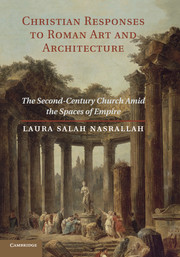 Christian Responses to Roman Art and Architecture
Christian Responses to Roman Art and Architecture Book contents
- Frontmatter
- Contents
- LIST OF FIGURES
- ACKNOWLEDGMENTS
- ABBREVIATIONS
- INTRODUCTION
- PART I FRAMING THE QUESTION, FRAMING THE WORLD
- PART II INTO THE CITIES
- 3 WHAT INFORMS THE GEOGRAPHICAL IMAGINATION? THE ACTS OF THE APOSTLES AND GREEK CITIES UNDER ROME
- 4 WHAT IS JUSTICE? WHAT IS PIETY? WHAT IS PAIDEIA? JUSTIN, THE FORUM OF TRAJAN IN ROME, AND A CRISIS OF MIMĒSIS
- PART III HUMAN BODIES AND THE IMAGE(S) OF GOD(S)
- EPILOGUE
- BIBLIOGRAPHY
- INDEX LOCORUM
- INDEX
- References
4 - WHAT IS JUSTICE? WHAT IS PIETY? WHAT IS PAIDEIA? JUSTIN, THE FORUM OF TRAJAN IN ROME, AND A CRISIS OF MIMĒSIS
from PART II - INTO THE CITIES
- Frontmatter
- Contents
- LIST OF FIGURES
- ACKNOWLEDGMENTS
- ABBREVIATIONS
- INTRODUCTION
- PART I FRAMING THE QUESTION, FRAMING THE WORLD
- PART II INTO THE CITIES
- 3 WHAT INFORMS THE GEOGRAPHICAL IMAGINATION? THE ACTS OF THE APOSTLES AND GREEK CITIES UNDER ROME
- 4 WHAT IS JUSTICE? WHAT IS PIETY? WHAT IS PAIDEIA? JUSTIN, THE FORUM OF TRAJAN IN ROME, AND A CRISIS OF MIMĒSIS
- PART III HUMAN BODIES AND THE IMAGE(S) OF GOD(S)
- EPILOGUE
- BIBLIOGRAPHY
- INDEX LOCORUM
- INDEX
- References
Summary
In literature, architecture, and even on coinage, the roman imperial family repeatedly claimed its commitment to and even embodiment of justice and piety. Justin's Apologies, which are addressed to the Roman emperors, the Senate, and the Roman people, contest such claims. This chapter shows how Justin's arguments about correct philosophy and religious practice (that is, topics usually treated by theologians) and about imperial power (that is, topics usually treated by historians) make sense in relation to imperial claims about culture, religiosity, and power, claims we have already seen in the emperor Hadrian's support of the Panhellenion. In the face of such representations of Roman imperial justice, piety, and even godhood, Justin struggles to define true religion and he debates the nature of true justice. Justin asks: How can one properly align the word (or name) and the thing it represents?
That Justin, who mentions Roman judicial persecution of Christians, would resist Rome is no surprise. That his resistance would be complex and sly, in the manner of a colonized elite speaking in the language of the dominant voice, is also no surprise. What is surprising and interesting is to see how both Justin and the Roman emperors work hard to define justice, paideia, and proper religious thought and practice. They do so from different positions of power and with different means and force of persuasion; we should not allow the passage of time to flatten all rhetoric onto a page so that we forget differences in the power to effect one's rhetoric.
- Type
- Chapter
- Information
- Christian Responses to Roman Art and ArchitectureThe Second-Century Church amid the Spaces of Empire, pp. 119 - 168Publisher: Cambridge University PressPrint publication year: 2010


